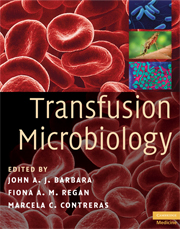Book contents
- Frontmatter
- Contents
- List of contributors
- Foreword
- Preface
- Acknowledgements
- Glossary
- Introduction: Transfusion-transmitted infections, then and now
- Section 1 Agents
- Section 2 Selection and testing
- Section 3 Surveillance, risk and regulation
- 21 Serious hazards of transfusion (SHOT); haemovigilance
- 22 Investigation of post-transfusion infection
- 23 Notification of donors with significant microbiological test results
- 24 Researching the natural history of transfusion-transmitted infections: the UK hepatitis C (HCV) national register
- 25 How to assess risk: prospective studies and calculations
- 26 Risk management
- 27 The regulatory environment in Europe
- 28 Blood safety in developing countries
- Index
- Plate section
- References
27 - The regulatory environment in Europe
from Section 3 - Surveillance, risk and regulation
Published online by Cambridge University Press: 12 January 2010
- Frontmatter
- Contents
- List of contributors
- Foreword
- Preface
- Acknowledgements
- Glossary
- Introduction: Transfusion-transmitted infections, then and now
- Section 1 Agents
- Section 2 Selection and testing
- Section 3 Surveillance, risk and regulation
- 21 Serious hazards of transfusion (SHOT); haemovigilance
- 22 Investigation of post-transfusion infection
- 23 Notification of donors with significant microbiological test results
- 24 Researching the natural history of transfusion-transmitted infections: the UK hepatitis C (HCV) national register
- 25 How to assess risk: prospective studies and calculations
- 26 Risk management
- 27 The regulatory environment in Europe
- 28 Blood safety in developing countries
- Index
- Plate section
- References
Summary
Introduction
When we look at the chequered history of the blood industry, a thrilling account of which is given by Douglas Starr (Starr, 1999) it is not surprising that legislation covering blood, blood components and industrially prepared plasma derivatives is increasing throughout the world.
The regulatory environments are complex and vary in different countries, as they depend on political structures, institutions and legal systems; all such environments change with time. The legislation in force is thus both time and place dependent.
This chapter will give a general overview of the regulatory environment in Europe in 2004, dealing with the legislation in the 25 member states of the European Union (European Union Member States in 2004: Germany, United Kingdom, France, Italy, Spain, Netherlands, Greece, Belgium, Portugal, Sweden, Austria, Denmark, Finland, Ireland, Luxembourg, Poland, Czech Republic, Hungary, Slovakia, Lithuania, Latvia, Slovenia, Estonia, Cyprus, Malta (total population: approx 470 million)). Whilst this legislation applies only in EU member states, the key issues are those generally addressed by legislation in one form or another throughout the world.
European Union legislation forms part of the ‘acquis communautaire’ of the EU and as countries join the EU (current candidate countries are Bulgaria, Romania, Croatia and Turkey) they will need to adopt the acquis and all it involves.
A clear distinction has to be made between two very distinct approaches to achieving blood safety: guidelines and law. Guidelines, recommendations and best practice are generally written in a language which allows interpretation; they are not legally binding.
- Type
- Chapter
- Information
- Transfusion Microbiology , pp. 363 - 368Publisher: Cambridge University PressPrint publication year: 2008

